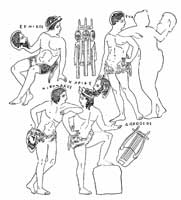.
Antikes Griechisches Theater, Masken, Schauspieler
[Solon] went to see Thespis himself, as the ancient custom was, act: and after the play was done, he addressed him, and asked him if he was not ashamed to tell so many lies before such a number of people; and Thespis replying that it was no harm to say or do so in play, Solon vehemently struck his staff against the ground: "Ah," said he, "if we honor and commend such play as this, we shall find it some day in our business." Plutarch: The Life of Solon

Mask from the 3rd c. BC
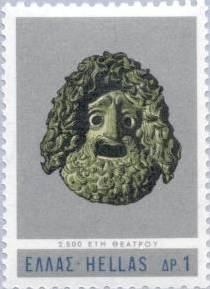
Mask from Piraeus, 4th c. BC National Museum of Athens
The Greeks did, however, develop one acoustical device of considerable value: the masks worn by actors. In addition to providing exaggerated facial expressions appropriate to the various roles, the masks served as megaphones that improved the mechanical coupling between the voice-generating mechanism and the surrounding air. From Architectural Acoustics ,
There were also other methods used to improve the acoustics:
So the vessels called yheia by the Greeks, which are placed in certain recesses under the seats of theatres, are fixed and arranged with a due regard to the laws of harmony and physics, their tones being fourths, fifths, and octaves; so that when the voice of the actor is in unison with the pitch of these instruments, its power is increased and mellowed by impinging thereon. Vitruvius, de Architectura
See also
..It allowed the actors to be seen and have there emotions understood. The subtle gestures of an actors face would little farther than the people in the first two or three rows. The mask was adopted as a tool to help them be more visible to all of the audience From Visibility

1751 : Theatre mask. Pentelic marble.
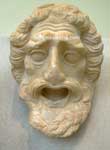
1752 : Theatre mask. Pentelic marble.
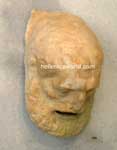
1753 : Theatre mask. Pentelic marble.
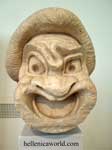
3373 : Theatre mask. Ruler slave, Pentelic marble.

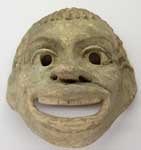
Greek and Roman Mask Timeline
terracotta figurines of New Comedy actors Greek, Myrina; 2nd century BCE
actor playing young man; actor playing young woman
Paris, Louvre Museum. Credits: Barbara McManus, 1999
terracotta figurine of comic actor with tympanos; Greek, 375-350 BCE
Paris, Louvre Museum. Credits: Barbara McManus, 1999
terracotta figurine of young woman holding mask
Greek, Tanagra; 325-300 BCE
other small terracotta masks surround the figure (see below for details)
Paris, Louvre Museum. Credits: Barbara McManus, 1999
terracotta mask of Dionysus Greek, Myrina; second-first century BCE
Paris, Louvre Museum. Credits: Barbara McManus, 1999
terracotta mask of young man Greek, Myrina; second century BCE
Paris, Louvre Museum. Credits: Barbara McManus, 1999
terracotta mask of young man Greek, Tunisia; second-first century BCE
Paris, Louvre Museum. Credits: Barbara McManus, 1999
tiny terracotta mask of bearded man Greek, Tunisia; second-first century BCE
Paris, Louvre Museum. Credits: Barbara McManus, 1999
votive relief of actors celebrating after performance Greek; c. 400 BCE
found in Piraeus; Athens, National Archaeological Museum. Credits: Barbara McManus, 1998
bronze theater tokens stamped with head of Athena or letter of the Greek alphabet
close-up of one token
Athens, fifth century BCE)
London, British Museum. Credits: Barbara McManus, 1999
detail, red-figure vase painting showing tragic performance
possibly Euripides' lost play Oineus
attributed to Python; Greek, Paestum, 340-330 BCE
view of orchestra of Greek theater at Delphi looking down from top rows of cavea; ruins of temple of Apollo in background
Delphi. Credits: John McManus, 1998
view of orchestra of Greek theater at Delphi looking down from side; ruins of temple of Apollo in background
Delphi. Credits: John McManus, 1998
view of cavea and orchestra of Theater of Dionysus looking down from Acropolis
Athens. Credits: Barbara McManus, 1980
view of cavea and orchestra of Theater of Dionysus on ground level
Athens. Credits: Barbara McManus, 1980
stone seat reserved for priest of Dionysus Eleutherios in Theater of Dionysus
Athens. Credits: Barbara McManus, 1980
detail of inscription on stone seat reserved for priest of Dionysus Eleutherios in Theater of Dionysus
Athens. Credits: Barbara McManus, 1980
scene building, orchestra, and cavea of Theater at Epidaurus viewed from ground level
Epidaurus. Credits: Barbara McManus, 1980
black-figure column krater—detail "eye vase" with mask of Dionysus; Athens, late sixth century BCE
New York, Metropolitan Museum of Art. Credits: Barbara McManus, 1982
black-figure vase of Dionysus sailing with dolphins; Greek, attributed to Exekias, c. 530 BCE
Munich, Antiken Sammlung. Credits: Barbara McManus, 1988
red-figure vase of Dionysus dancing with torn-apart animal; Greek, 480-460 BCE
London, British Museum. Credits: Barbara McManus, 1986
statue of youthful Dionysus; Roman copy of Greek marble
London, British Museum. Credits: Barbara McManus, 1986
statue of youthful Dionysus; free Roman copy of fourth-century BCE Greek original
Munich, Glyptothek. Credits: Barbara McManus, 1988
tiny terracotta comic figurine, Greek from Knidos, c. 300 BCE
represents either an actor or a buffoon in the mysteries of Demeter.
London, British Museum. Credits: Barbara McManus, 2001
terracotta comic figurine; detail of mask, Greek from Myrina, 2nd century BCE
represents a masked actor, possibly the procurer of New Comedy.
London, British Museum. Credits: Barbara McManus, 2001
terracotta comic figurine, Greek from Athens, c. 330-300 BCE
represents an actor of New Comedy, probably a traveler or soldier.
London, British Museum. Credits: Barbara McManus, 2001
terracotta comic figurine, Greek from Athens, c. 300-150 BCE
represents an actor of New Comedy.
London, British Museum. Credits: Barbara McManus, 2001
terracotta comic figurine, Greek from Cyrenaica, c. 350 BCE
represents an actor portraying an old woman.
London, British Museum. Credits: Barbara McManus, 2001
terracotta comic figurine, Greek from Athens, c. 350 BCE
represents an actor portraying an old woman.
London, British Museum. Credits: Barbara McManus, 2001
terracotta comic figurine, Greek from Athens, c. 350 BCE
represents an actor portraying a young woman adjusting her himation.
London, British Museum. Credits: Barbara McManus, 2001
terracotta comic figurine, Greek, late Hellenistic period
represents an actor portraying a slave.
Athens, Cycladic Museum. Credits: Barbara McManus, 2002
Alexander, the tyrant of Pherae (this last should be his only appellation; he should not be permitted to disgrace the name of Alexander), as he watched a tragic actor, felt himself much moved to pity through enjoyment of the acting. He jumped up, therefore, and left the theatre at a rapid pace, exclaiming that it would be a dreadful thing, if, when he was slaughtering so many citizens, he should be seen to weep over the sufferings of Hecuba and Polyxena. And he came near visiting punishment upon the actor because the man had softened his heart, as iron in the fire. Plutarch, Moralia: "On the Fortune of Alexander."
 |
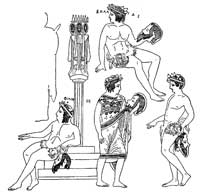 |
Actors with masks, Click images to enlarge
http://www.stoa.org/metis/cgi-bin/qtvr?site=theater Epidauros Theater Virtual Tour
http://www.stoa.org/metis/cgi-bin/qtvr?site=miletos Theater of Miletos Virtoual Tour
Drama Day 2000 : Mask Workshop
The use of Costumes and Props in Tragedy
http://www.whitman.edu/theatre/theatretour/home.htm
Pronomos Vase showing Dionysos and the cast of a satyr play (Perseus)
Chorergos Vase (Getty)
One famous story of ancient Greece was that of the actor Polus performing in the Electra of Sophocles, at Athens in the 4th century BC. The plot requires Electra to carry an urn supposed to contain the ashes of Orestes. Polus brought the ashes of his dead son on stage so as to generate the requisite feelings for a cry of lamentation.
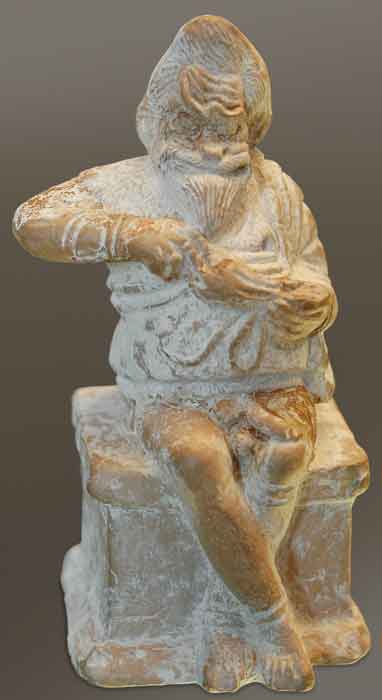
Actor playing the role of a slave sitting on an altar and emptying the purse he just stole. Made in Boeotia, ca. 400–375 BC. Height 3,75 inches. Location: Louvre, Department of Greek, Etruscan and Roman Antiquities (CA 265) [Source]

Woman holding a theatrical mask. Terracotta figurine made in Tanagra, ca. 325–-300 BC, Louvre, Department of Greek, Etruscan and Roman Antiquities (MNB 555) [Source]

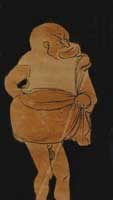
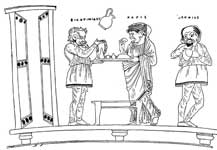
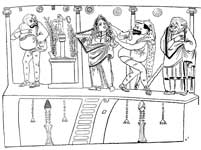

Phylax Scene, Parody of Heracles with the Cercopes

Actor, BM C827

See also
When I find myself in the shell of an ancient theater I look at the landscape, beyond, always so much well chosen and immediately then I look around the spectators. I try to see their eyes, thousands eyes in line. Looking at a detail, at a a moment which cannot be transmitted to others. Not at a concrete action that I could easily suppose... The eyes extinguish with their emotions, as stars die and what remains is the empty space, so much desertness. G. Seferis ( Γ. Σεφέρης, "Μέρες", Δευτέρα 26 Ιουνίου 1950 Στρατονίκεια Αντιόχου Σωτήρος , from a Greek Website)
| Ancient Greece
Science, Technology , Medicine , Warfare, , Biographies , Life , Cities/Places/Maps , Arts , Literature , Philosophy ,Olympics, Mythology , History , Images Medieval Greece / Byzantine Empire Science, Technology, Arts, , Warfare , Literature, Biographies, Icons, History Modern Greece Cities, Islands, Regions, Fauna/Flora ,Biographies , History , Warfare, Science/Technology, Literature, Music , Arts , Film/Actors , Sport , Fashion --- |

